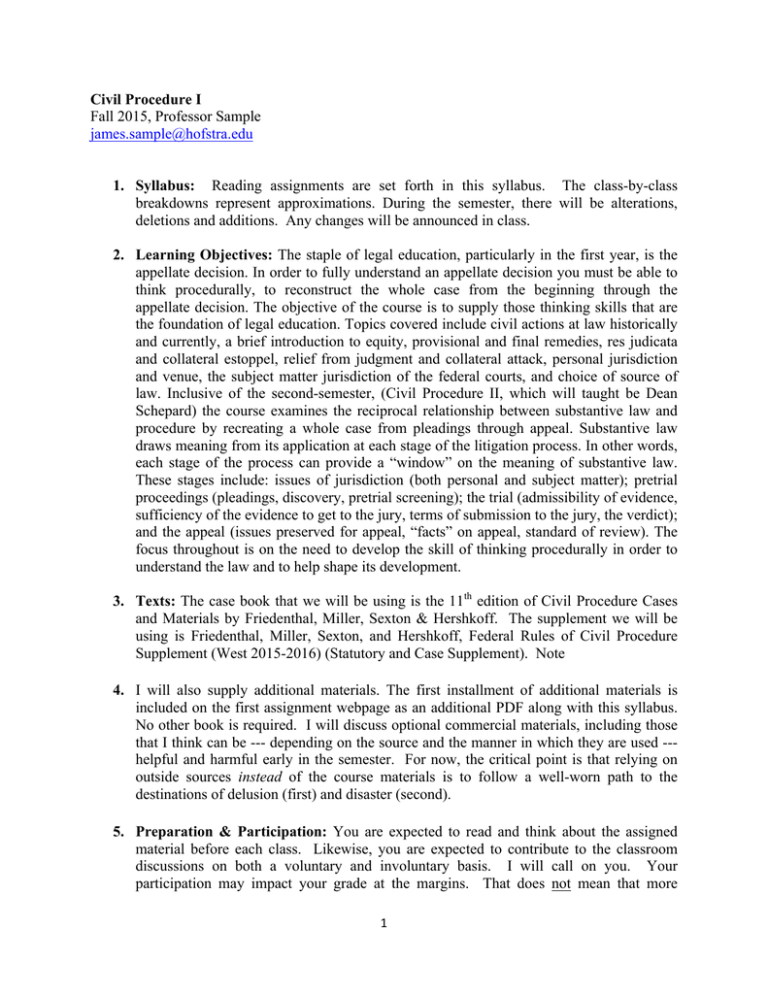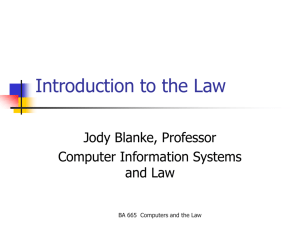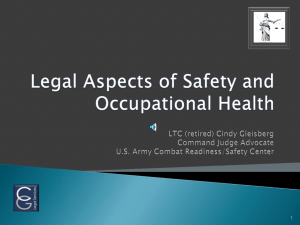Civil Procedure I 1. Syllabus: Fall 2015, Professor Sample
advertisement

Civil Procedure I Fall 2015, Professor Sample james.sample@hofstra.edu 1. Syllabus: Reading assignments are set forth in this syllabus. The class-by-class breakdowns represent approximations. During the semester, there will be alterations, deletions and additions. Any changes will be announced in class. 2. Learning Objectives: The staple of legal education, particularly in the first year, is the appellate decision. In order to fully understand an appellate decision you must be able to think procedurally, to reconstruct the whole case from the beginning through the appellate decision. The objective of the course is to supply those thinking skills that are the foundation of legal education. Topics covered include civil actions at law historically and currently, a brief introduction to equity, provisional and final remedies, res judicata and collateral estoppel, relief from judgment and collateral attack, personal jurisdiction and venue, the subject matter jurisdiction of the federal courts, and choice of source of law. Inclusive of the second-semester, (Civil Procedure II, which will taught be Dean Schepard) the course examines the reciprocal relationship between substantive law and procedure by recreating a whole case from pleadings through appeal. Substantive law draws meaning from its application at each stage of the litigation process. In other words, each stage of the process can provide a “window” on the meaning of substantive law. These stages include: issues of jurisdiction (both personal and subject matter); pretrial proceedings (pleadings, discovery, pretrial screening); the trial (admissibility of evidence, sufficiency of the evidence to get to the jury, terms of submission to the jury, the verdict); and the appeal (issues preserved for appeal, “facts” on appeal, standard of review). The focus throughout is on the need to develop the skill of thinking procedurally in order to understand the law and to help shape its development. 3. Texts: The case book that we will be using is the 11th edition of Civil Procedure Cases and Materials by Friedenthal, Miller, Sexton & Hershkoff. The supplement we will be using is Friedenthal, Miller, Sexton, and Hershkoff, Federal Rules of Civil Procedure Supplement (West 2015-2016) (Statutory and Case Supplement). Note 4. I will also supply additional materials. The first installment of additional materials is included on the first assignment webpage as an additional PDF along with this syllabus. No other book is required. I will discuss optional commercial materials, including those that I think can be --- depending on the source and the manner in which they are used --helpful and harmful early in the semester. For now, the critical point is that relying on outside sources instead of the course materials is to follow a well-worn path to the destinations of delusion (first) and disaster (second). 5. Preparation & Participation: You are expected to read and think about the assigned material before each class. Likewise, you are expected to contribute to the classroom discussions on both a voluntary and involuntary basis. I will call on you. Your participation may impact your grade at the margins. That does not mean that more 1 talking is better. It does mean that preparation is expected; regular participation is part of the class; and that the nature of your participation is expected to be at a high level, such that your contributions are genuinely contributions to your classmates. 6. TWEN: There is a TWEN page for this course. To register (1) go to lawschool.westlaw.com (2) click on TWEN (3) choose “add course” and add this course. Once you have registered you will have the ability to engage in substantive discussions with your fellow students. I will also use TWEN to post course materials. I encourage you to use the TWEN list serve to discuss substantive matters relating to the course. I may monitor these discussions as a matter of interest, but will not be intervening as a matter of course. 7. Attendance: You may miss no more than six class hours this semester. Accommodations may be made in truly compelling circumstances. In the event you believe yourself to be in such circumstances, you should send an e-mail to me within twenty-four hours of your absence. I will do nothing respecting these issues until late in the semester. At that point, I will review the file of anyone with more than six hours of missed class and determine whether to forward the file to the Office of Student Affairs possibly resulting in denying you credit for the course. All of the above pertains only to the bare minimum floor for attendance. Early in the term, we will have a couple of extended and/or additional sessions on dates TBA. 8. Exams: Your grade will turn primarily on a final exam at the end of the semester. More will be said about this in due course. I will be covering matters in class that are not part of the readings, and your readings will cover matters that are not covered in class. All of it is fair game for the exams. You will develop a good sense of the relative import of the material as the semester develops, but I will also give some additional specific guidance on this in the period leading up to the exam. 9. Laptops: As you know, several professors have banned laptops. Personally, I think they are doing you a favor, but after much deliberation, I have decided that you are allowed --but not encouraged --- to use your laptops for note-taking purposes. Using laptops for other purposes (chatting, emailing, surfing, gaming) is prohibited, mostly because it is distracting for both you and those around you. A compelling articulation of the view that handwritten note-taking promotes greater overall learning may be found at Dorf on Law, http://michaeldorf.org/2006_11_01_archive.html 10. Simulation exercises: Although they will receive greater emphasis in your Spring semester (Civil Procedure II), than in the Fall, your grade will also involve your performance in a series of simulated exercises over the course of the semester. You will be assigned to work in a law firm group and you will be given a few different assignments in connection with a fictional client’s situation. These assignments will provide you with your first opportunities to see how what you have learned over the course of the semester can/should be applied in a practice setting. 2 11. Teaching Fellows: We are fortunate to have two outstanding Teaching Fellows who will be working with our class this semester, and again in your Civil Procedure II course in the Spring. Edward Warnke and Sean Brucker are outstanding 2Ls, who notably excelled in the Civil Procedure Course. I will introduce them to you in person early in the term. Their email addresses are ewarnke1@pride.hofstra.edu and svb444@gmail.com . Ed and Sean will be conducting a couple of review sessions, and will also be available for individual and/or small group questions. 12. Office: You are welcome to drop by at any time; if I’m in and can’t meet with you right away, we’ll find a time to do so. My “formal” office hours will be determined early in the semester (once various committee and other obligations are determined) and I will coordinate these with your section’s class schedule to the extent feasible. NB: Reading assignments begin below. Preliminary schedule of readings. Class 1 – Overview (Read prior to 1st class session) Read pp. 1-27 Read Note on the Arrival of Modern Procedure, pp. 550-551 Look at Judicial Map, “Geographic Boundaries of United States Courts of Appeals and United States District Courts (contained within the PDF of supplemental materials) Read Avista Management, Inc. v. Wausau Underwriters Insurance Company (contained within the PDF of supplemental materials) * Professor Freedman’s “Eight Minutes of Reading on Eight Hundred Years of Procedure to Help You Understand the Next Eight Months” (contained within the PDF of supplemental materials). Module 2 – Quick Intro to Judicial Authority; Pleading Read Capron v. Van Noorden, pp. 28-29 Read Tickle v. Barton, pp. 30-34, through Note 1 Read Case v. State Farm Mutual Automobile Insurance Co., pp. 35-37 Note the following definitions: • Alias process – “When some court process (it could be a subpoena, a summons, a warrant, or a writ) expires in effectiveness before it can be used, or is used but does not completely achieve what it was supposed to do (e.g., a summons could not be served on all the defendants, or a writ of execution was unsuccessful in garnering enough property to cover a judgment), a second or subsequent document may be issued, which will be called an “alias” one, e.g., “alias summons,” “alias subpoena,” “alias warrant,” “alias writ,” etc.).” Source: The Leff Dictionary of Law, 94 Yale L.J. 1855, 1992 (1985). 3 • Plea in abatement – At common law, a response to the complaint that does not challenge the merits of the claim but rather raises defects relating to such matters as the location of the action, the place of trial, or wrongful joinder. See Koffler & Reppy, Handbook of Common Law Pleading 416429 (1969). In the federal system, Federal Rule 12(b)(1) through (5) and (7) are the modern counterparts to the common law plea in abatement. Module 3 – Quick intro to Joinder and the Scope of the Lawsuit Read Temple v. Synthes Corp., pp. 38-39 Read Introduction to Joinder (within PDF of distributed supplemental materials) Module 4 – Personal Jurisdiction: The Traditional Bases Read Pennoyer v. Neff, pp. 75-84 (through note 4) Note the following definitions: • Special appearance – a procedure that allows a defendant to challenge a court’s exercise of personal jurisdiction without submitting to the court’s power for any other purpose • Collateral attack – a challenge to the enforcement of a judgment typically arguing that the rendering court lacked jurisdiction • Limited appearance – a procedure that allows a defendant in an action commenced on a quasi-in-rem basis to appear for the limited purpose of defending his interest in the attached property without submitting to the court’s excise of full personal jurisdiction Module 5 – Personal Jurisdiction: Expanding the Bases and a New Approach Read Hess v. Pawloski, pp. 87-90 Read International Shoe Co. v. Washington, pp. 90-97 Read Gray v. American Radiator, pp. 97-103 SKIM Community Trust Bancorp, Inc. v. CTFC pp 159-163 Module 6-7 – Personal Jurisdiction: Specific Jurisdiction, Long-Arm Statutes, and Due Process Read pp. 103-104 Read McGee v. International Life Insurance Co., pp. bottom 104-105 Read Hanson v. Denckla, pp. 105-108 Read World-Wide Volkswagen Corp. v. Woodson, pp. 109-118 Read Kulko v. Superior Court of California, p. 119 Read Burger King Corp. v. Rudzewicz, pp. 120-124 Read Asahi Metal Industry Co. v. Superior Court, pp. 124-132 SKIM J. McIntyre Machinery, Ltd. v. Nicastro, pp. 133-150 Review simulation materials (available on TWEN) Simulation Assignment #1 (Fact Investigation Memos (to be discussed)) 4 Module 8 - Personal Jurisdiction: General Jurisdiction Read Perkins v. Benguet Consolidated Mining Co., pp. to be distributed Read Helicopteros Nacionales de Colombia, S.A. v. Hall, pp. to be distributed Notes and Questions, pp. 157-158 Goodyear Dunlop Tires Operations, S.A. v. Brown, pp. 151-158 Module 9-10 – Jurisdiction Based upon Power over Property: In rem and Quasi-in-rem Jurisdiction Reread Pennoyer v. Neff Pennington v. Fourth National Bank of Cincinnati, Ohio, p 165 Note and Question, p. 166 Harris v. Balk, pp. 166-167 Notes and Questions, pp. 167 Shaffer v. Heitner, pp. 167-180 Notes and Questions, pp. 180 Module 11 – Personal Jurisdiction: Presence and Consent Read Burnham v. Superior Court, pp. 180-191 Read Insurance Corp. of Ireland, Ltd. v. Compagnie des Bauxites de Guinée, pp. 191-193 Read M/S Bremen v. Zapata Off-Shore Co., p. 194-195 Read Carnival Cruise Lines, Inc. v. Shute, pp. 195-196 Module 12 – Personal Jurisdiction and the Federal District Courts Read p. 196-197 Read Federal Rule 4 Module 13 – Subject-Matter Jurisdiction: Introduction and State Court Power Read Intro Note to Chapter 4, pp. 259-260 Read Lacks v. Lacks, pp. 260-263, especially Note 1 p. 263 Read U.S. Const. Art. III, § 2 Module 14-16 – Subject-Matter Jurisdiction of the Federal Courts: Diversity of Citizenship Read pp. 266-271 Read 28 U.S.C. § 1332 Read Mas v. Perry, pp. 271-274 Read Notes, pp 274-275 (Dred Scott, Hertz) Read A.F.A. Whitchurch, pp 282-285 Read Note on Judicially Created Exceptions to Diversity Jurisdiction, pp. 289-291 Module 17-19 – Subject-Matter Jurisdiction of the Federal Courts: Arising Under Jurisdiction Read Notes inclusive of Osborn v. Bank of the United States, pp. 291 (Notes)-294 Read 28 U.S.C. § 1331 5 Read Louisville &. Nashville R. Co. v. Mottley, pp. 296-298 Read Note on Private Rights of Action, pp. 303 Read Shoshone Mining Co. v. Rutter, p. 304 Read Smith v. Kansas City Title & Trust Co., pp. 304 Read Moore v. Chesapeake & Ohio Railway Co., pp. 305 Read Merrell Dow Pharmaceuticals Inc. v. Thompson, pp. 305-306 Read Grable & Sons Metal Products, Inc. v. Darue Engineering & Manufacturing, pp. 306-311 Read Empire Healthchoice Inc. v. McVeigh, pp. 311-313 Read Gunn v. Minton, pp 313-316 Module 20-21 – Subject-Matter Jurisdiction of the Federal Courts: Pendent, Ancillary, and Supplemental Jurisdiction; Removal Jurisdiction Read Introductory Note on pp. 318-319 Read United Mine Workers of America v. Gibbs, pp. 318-324 Read Notes on Pendent and Ancillary Jurisdiction Following Gibbs, pp. 324-329 Read 28 U.S.C. § 1367 Read Exxon Mobil Corp. v. Allapattah Services, Inc., pp. 330-338 Read Executive Software North America, Inc. v. United States District Court for the Central District of California, pp. 339-343 Read 28 U.S.C. § 1441 et al (listed on p 345) & notes pp. 345-346 Module 22 – Venue and Forum non Conveniens Read pp. 359-363 Read Reasor-Hill Corp. v. Harrison, pp. 363-368 Read Bates v. C & S Adjusters, Inc., pp. 368-372, through Note 9 Read 28 U.S.C. §§ 1404, 1406, 1407 Read Hoffman v. Blaski, pp. 373-379 Read Gulf Oil Corp. v. Gilbert, pp. 383-384 Read Piper Aircraft Co. v. Reyno, pp. 384-392 Module 23-25 – State Law in the Federal Courts Read pp. 397-400 (esp. Swift v. Tyson note) Read Erie R. Co. v. Tompkins, pp. 400-409 Read Guaranty Trust Co. v. York, pp. 409-416 (through Note 3) Read Byrd v. Blue Ridge Rural Electric Cooperative, Inc., pp. 418-422 Read 28 U.S.C. § 2072 Read Hanna v. Plumer, pp. 423-430 Gasperini v. Center for Humanities, Inc., pp. 446-455 Shady Grove Orthopedic v. Allstate Co., pp. 456-469 Module 26 – Determining State Law; Federal Common Law; Federal Law in State Courts Read pp. 469-470, especially Klaxon Co. v. Stentor Electric Mfg. Co., p. 496 Read pp. 476-478 Read Note on Federal Common Law and Federal Rules of Preclusion, p. 490 Read Note 1 on Federal Law in the State Courts, pp. 495 6






